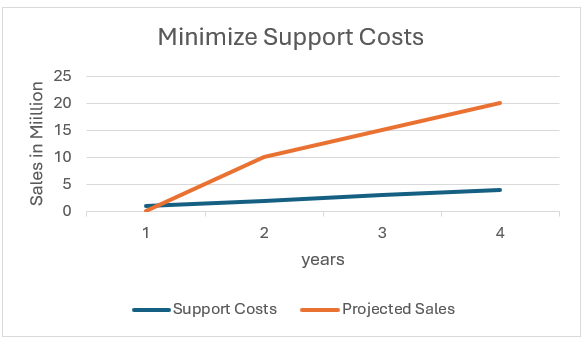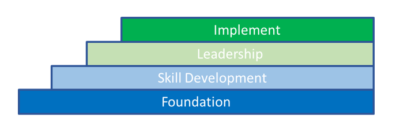Strategic Sourcing and Management

The Appleton Greene Corporate Training Program (CTP) for Strategic Sourcing and Management is provided by Dr. Bonhag Certified Learning Provider (CLP). Program Specifications: Monthly cost USD$2,500.00; Monthly Workshops 6 hours; Monthly Support 4 hours; Program Duration 12 months; Program orders subject to ongoing availability.
Personal Profile
Dr. Bonhag is an approved certified learning provider (CLP) at Appleton Greene and is a business leader and strategist with broad experience in the healthcare delivery, global pharmaceutical, and health insurance sectors. He has worked with premier companies, including Universal Health, Blue Cross & Blue Shield, ICON, Fresenius Medical Care, Innovage, Priority Health, Highmark, MidState Medical Center, and Mercy Healthcare.
He has personally led the selection and management of more than 30 transformational implementations involving strategic sourcing and managing those vendors to success. In some cases, an existing application can benefit the company; in other cases, developing a robust solution requires the external expertise of a developer vendor. It is crucial to select the correct strategy and to ensure that the resultant solution meets the Key Performance Indices (KPIs) and Return on Investment (ROI) for which the project was initiated.
As a seasoned operational leader, whether as a Chief Operating Officer for a 425-bed teaching hospital, Director of Managed Care supporting 350,000 members, or freelance Program manager assisting hospitals, health plans, or delivery systems, he has the experience to help you overcome the challenges of selecting the right vendor and solution.
He is an experienced trainer and mentor sought out by his previous clients to help them with program and project management and strategic sourcing for operational excellence. He has real-world experience with implementing new products and improving the operations. He draws on that experience from 30 companies to lead your team through the steps to be successful.
His formal education includes earning a Master of Business Administration in Finance and Information Systems from Duke University, a bachelor’s in mathematics and physics from Franklin & Marshall College, and a Doctorate from Fairleigh Dickinson University.
To request further information about Dr. Bonhag through Appleton Greene, please Click Here.
(CLP) Programs
Appleton Greene corporate training programs are all process-driven. They are used as vehicles to implement tangible business processes within clients’ organizations, together with training, support and facilitation during the use of these processes. Corporate training programs are therefore implemented over a sustainable period of time, that is to say, between 1 year (incorporating 12 monthly workshops), and 4 years (incorporating 48 monthly workshops). Your program information guide will specify how long each program takes to complete. Each monthly workshop takes 6 hours to implement and can be undertaken either on the client’s premises, an Appleton Greene serviced office, or online via the internet. This enables clients to implement each part of their business process, before moving onto the next stage of the program and enables employees to plan their study time around their current work commitments. The result is far greater program benefit, over a more sustainable period of time and a significantly improved return on investment.
Appleton Greene uses standard and bespoke corporate training programs as vessels to transfer business process improvement knowledge into the heart of our clients’ organizations. Each individual program focuses upon the implementation of a specific business process, which enables clients to easily quantify their return on investment. There are hundreds of established Appleton Greene corporate training products now available to clients within customer services, e-business, finance, globalization, human resources, information technology, legal, management, marketing and production. It does not matter whether a client’s employees are located within one office, or an unlimited number of international offices, we can still bring them together to learn and implement specific business processes collectively. Our approach to global localization enables us to provide clients with a truly international service with that all important personal touch. Appleton Greene corporate training programs can be provided virtually or locally and they are all unique in that they individually focus upon a specific business function. All (CLP) programs are implemented over a sustainable period of time, usually between 1-4 years, incorporating 12-48 monthly workshops and professional support is consistently provided during this time by qualified learning providers and where appropriate, by Accredited Consultants.
Executive summary
Strategic Sourcing and Management
Strategic Sourcing and Management: Pain Points
Why would you want to implement a strategic sourcing and vendor management system? You may have experienced one or more of these issues in your organization. This course will overcome these issues.
Incomplete or Ineffective Solution:
The implemented system may need more critical features or functions to meet business objectives. Missing the objectives can result in an ineffective solution that doesn’t address the organization’s core needs. The designed system may cause further inefficiencies if it does not integrate with existing workflows. Inefficient systems will cause drops in productivity and overall business performance.
Poor Performance:
A lack of performance monitoring and evaluation can lead to suboptimal vendor performance. Poor system performance may impact the quality of services or products and hinder achieving business goals.
Loss of Competitive Advantage:
Innovation and strategic differentiation are crucial for maintaining a competitive advantage; thus, vendors who need help understanding the importance of innovation can lose that advantage.
Quality issues:
The implemented solution’s quality is needed to meet the organization’s standards, leading to operational disruptions and patient dissatisfaction. Failure to satisfy regulatory or compliance requirements due to missing system features can result in legal consequences and fines.
Reliability and dependability:
Vendors who fail to meet deadlines or consistently deliver late can disrupt your supply chain and production schedules, affecting your overall business operations.
Financial challenges:
Hidden Costs: Some vendors may need to be more transparent about their pricing structure, leading to unexpected costs that can strain your budget and impact profitability. Those costs could be both in the implementation and the system’s operations. The total cost of ownership needs to be better defined.
Communications:
Poor Communication: Difficulty in communication can lead to misunderstandings, delays, and misaligned expectations, impacting project timelines and outcomes. Ineffective communication and a lack of transparency can lead to a better understanding between the business and the vendor. Communication may result in misaligned expectations, clarity, and disputes.
Data Security and Compliance:
Security Risks: Choosing a vendor with weak data security measures can expose your business to potential data breaches, compromising sensitive information.
Scalability:
Lack of Scalability: A vendor’s products or services must scale with your business growth to avoid facing limitations and needing new solutions. The vendor must include scaling the software to ensure business growth expectations.
Customer support:
Inadequate Support: Poor customer support from a vendor can result in unresolved issues, delays in problem resolution, and frustration for your team.
Technology misalignment:
Incompatibility: Selecting a vendor whose technology or systems are incompatible with your existing infrastructure can lead to integration challenges and inefficiencies.
Cultural fit:
Misalignment of Values: Differences in organizational culture and values between your company and the vendor can lead to conflicts and difficulties in collaboration.
Contractual Issues:
Ambiguous Contracts: Poorly drafted or ambiguous contracts can result in legal disputes, and you may need more protection if issues arise.
This course will help the management of your organization accomplish key performance indicators (KPIs) and return on investment (ROI) as they undertake a strategic initiative. In most cases, strategic initiatives involve designing solutions that leverage information systems, with the implementation of those solutions being internal or external to the company. When a company addresses a significant strategic advantage where it must not fail and when internal resources are already fully committed, it may be necessary, if not a better option, to select external IT work or off-the-shelf software. Selecting external, proven staff or software will minimize the risks of that initiative. Suppose the need for external resources becomes apparent. In that case, it is equally clear that it is essential to create the basics of vendor requirements, vendor selection, and managing those vendors to a successful conclusion.
Define Clear Requirements:
Ensure that the business requirements are well-defined and documented. These are functional, system, and integration requirements, or how the system will operate for the business. As we move through this process, the definition of requirements becomes a significant focus. Elaborating requirements based on business processes and improvement methods is essential. There are several successful requirement-gathering tools available. Most existing requests (requests for information, requests for a quote, or requests for proposals) are designed to meet the legal requirements but fail to ensure that the vendor understands what is required. Based on that information, we have revised these requests.
Conduct Due Diligence:
Research the vendor’s reputation, experience, and track record. Look for reviews, testimonials, and case studies from other clients. Check references and seek feedback from organizations that have worked with the vendor before.
Request Documentation:
Ask the vendor for relevant documentation, such as employee manuals, certifications, compliance reports, and security policies. Documentation helps ensure that the vendor follows industry standards and meets regulatory requirements.
Site Visits and Audits:
Consider conducting site visits or audits, especially for critical vendors or those providing essential services. Site visits allow a firsthand assessment of the vendor’s facilities, processes, and overall capabilities.
Actual use-case demonstrations:
Provide one or two representative use cases with actual examples so that the vendor can provide proof that the vendor understands the complexity of the business uses.
Proof of Concept (PoC) or Pilot:
Request proof of concept or a pilot project to assess the vendor’s ability to meet specific requirements. A pilot can be a smaller-scale project that allows you to evaluate the vendor’s performance before committing to a more extensive engagement.
Performance Metrics and Key Performance Indicators (KPIs):
Establish performance metrics and KPIs that align with your business goals. These could include delivery timelines, quality standards, and other relevant performance indicators. Monitor and measure the vendor’s performance against these metrics. Defining expected ROI and KPIs in advance enhances any strategic initiative’s product development and process improvement efforts.
Contractual Clarity:
Ensure the contract with the vendor is evident, including all requirements, responsibilities, and expectations. This document should provide a basis for evaluating the vendor’s performance and holding them accountable.
Regular Communication:
Communicate with vendors regularly. Establish a feedback loop to address any issues promptly and to keep both parties informed of expectations and changes in requirements.
Quality Assurance and Testing:
Depending on the nature of the vendor’s deliverables, conduct quality assurance and testing processes. Testing may involve reviewing samples, conducting product testing, or assessing the services’ functionality.
Continuous Monitoring:
Implement continuous monitoring processes to track the vendor’s performance over time. Regularly reassess the vendor’s capabilities and adjust to ensure ongoing alignment with business requirements.
Exit Strategy:
Develop an exit strategy in case the vendor fails to meet expectations. Clearly define the conditions under which you can terminate the contract and establish contingency plans to mitigate potential disruptions.
Legal Compliance:
Your vendors must meet regulatory demands. Compliance includes data protection laws, industry-specific regulations, and other applicable standards.
Strategic Sourcing and Management is a corporate-focused educational program that affects the whole company rather than focusing on only one aspect. If only focused on one aspect, the effect of the training efforts results in little to no real improvement in the company’s overall performance.
An updated strategic vendor selection and management process will pay dividends for a project’s overall success and efficiency.
Firstly, the meticulous vendor selection criteria ensure the company engages with partners who provide high-quality products or services and aligns with the organization’s values and strategic goals. This alignment fosters a collaborative and synergistic relationship between the company and its vendors, promoting long-term success.
Strategic vendor management is crucial for optimizing costs and maximizing value, and the trainee’s approach reflects a keen understanding of this principle. The company can mitigate risks and enhance operational resilience by consistently evaluating vendor performance, negotiating favorable terms, and ensuring contractual compliance. The trainee’s emphasis on transparent communication and feedback mechanisms with vendors establishes a foundation for continuous improvement, allowing for timely adjustments and adaptations to meet evolving business needs.
Furthermore, the strategic vendor management practices contribute to innovation and technological advancement within the company. By fostering a collaborative environment with vendors, the organization gains access to industry insights, cutting-edge solutions, and emerging trends, positioning itself as a forward-thinking and adaptable player in the market. This proactive approach enables the trainee’s company to stay ahead of the competition and deliver enhanced customer value.

At the $2 billion yearly global organization ICON, which has its headquarters in Ireland, we created a new set of procedures to support the launch of a new product. The processes required to enable the delivery and sales of the product were developed from the ground up. Throughout that process, it became clear that maintaining the consistency and transparency of those protocols required a deliberate approach. With multiple clients and multiple variations of the product inside each client, we thought a software solution would be helpful. The sales and delivery processes were defined by hand. Based on that time-consuming method, we developed specific conditions that must be met. We looked at many software possibilities and found three that worked well for us. After defining the requirements, we sent out a thorough request for bids, examined the responses, and assessed each solution through the demonstrations. Consequently, we were able to install the chosen system successfully. Confirming that our needs were satisfied. The product went on sale precisely as planned, and the software supported the procedures and personnel without the need for additional hiring when volume increased. The year following its launch, the new product brought in almost $10 million in sales. The strategic sourcing and management of the vendor has been a true success story; trainees now look to it as an example.
The trainee benefits personally from this strategic vendor selection and management approach by gaining valuable experience in negotiation, relationship building, and risk management—essential skills in today’s dynamic business environment. Additionally, the trainee’s proficiency in vendor management contributes to the company’s bottom line by optimizing costs, improving efficiency, and ensuring the successful delivery of products or services. Overall, the strategic vendor, selection, and management practices implemented by the trainee demonstrate a forward-looking and holistic approach that benefits the company’s current operations and positions it for sustained success in the future.
Attending the Strategic Sourcing and Management course is paramount for the trainee and his company, given their current position and practices in vendor selection and management. The comprehensive approach outlined in the strategic sourcing and management processes reflects a commitment to excellence and diligence in ensuring optimal outcomes. The course offers an opportunity for further refinement and enhancement, providing several compelling reasons for participation.
The Strategic Sourcing and Management course complements the trainee’s practices by offering advanced insights, methodologies, and vendor selection and management strategies. By attending, the trainees can elevate their skills, contribute to further improvements in their company’s operations, and position themselves as a strategic asset capable of successfully navigating the complexities of vendor relationships.
In summary, the trainee’s commitment to strategic vendor management and participation in the Strategic Sourcing and Management course position them and their company for sustained success by enhancing skills, refining practices, and staying ahead in an ever-evolving business landscape.
Curriculum
Strategic Sourcing and Management – Part 1- Year 1
- Part 1 Month 1 Obtaining the Value
- Part 1 Month 2 Defining Project Requirements
- Part 1 Month 3 Identifying Vendors
- Part 1 Month 4 Preparing the Requests
- Part 1 Month 5 Vendor Proposal
- Part 1 Month 6 Proposal Evaluations
- Part 1 Month 7 Organizational Change
- Part 1 Month 8 Definition of the Work to be done
- Part 1 Month 9 Vendor Adherence
- Part 1 Month 10 Change Request
- Part 1 Month 11 Quality Compliance
- Part 1 Month 12 Lessons Learned
Program Objectives
The following list represents the Key Program Objectives (KPO) for the Appleton Greene Strategic Sourcing and Management corporate training program.
Strategic Sourcing and Management – Part 1- Year 1
- Part 1 Month 1 Obtaining the Value – One tactic in innovation is to find and leverage outside talent to boost the organization’s profitability while minimizing outsourcing risks. We will need external talent and resources to amplify our internal capacity. It will be essential to understand how other companies have developed the infrastructure required to obtain value for the company, not only for one project but for all their outsourcing projects. We will cover the following components:
• Key Performance Indicators (KPIs): Specify the essential KPIs relevant to sourcing and vendors in IT projects. Examples include return on investment, total cost of ownership, cost savings, project delivery time, quality of deliverables, vendor responsiveness, and customer satisfaction.
• Benchmarking and Industry Best Practices: Explore industry best practices in strategic sourcing and vendor management—examples of successful organizations effectively leveraging external talent and resources to drive innovation. Benchmarking against industry leaders can provide valuable insights.
• Risk Mitigation Strategies: Discuss strategies for mitigating outsourcing risks. Identify common challenges in outsourcing IT projects and propose risk management strategies. Mitigations could include contractual agreements, performance monitoring, and contingency planning.
• Case Studies: Present real-world case studies of organizations that have successfully obtained value through strategic sourcing and vendor management. Highlight the challenges faced, the strategies employed, and the outcomes achieved. The use of case studies and simulations will add to the learning.
• Talent Management Strategies: Explore practical ways to manage external talent, including consultant onboarding, skill assessment, and knowledge transfer. Discuss methods for integrating external resources seamlessly into existing teams and processes.
• Technology Platforms and Tools: Introduce relevant technologies and tools that facilitate vendor management and collaboration. These tools could include project management software, communication platforms, and performance analytics tools that support effective collaboration with external partners.
• Continuous Improvement Framework: Outline a framework for continuous improvement in vendor management processes. Emphasize learning from each project and updating strategies and procedures accordingly.
• Legal and Compliance Considerations: Learn how to address data protection, intellectual property rights, and regulatory compliance. Learn how to navigate these issues effectively.
• Scalability and Flexibility: Discuss how to build a vendor management infrastructure that is scalable and flexible as the organization changes. Consider business growth, changing project requirements, and technological advancements.
• Stakeholder Communication: Highlight the significance of effective communication with internal and external stakeholders. Discuss strategies for maintaining transparency, resolving conflicts, and fostering a collaborative environment.
By incorporating these elements, the “Obtaining the Value” portion will provide a more comprehensive guide for organizations looking to optimize their vendor selection and management processes for IT projects.
- Part 1 Month 2 Defining Project Requirements – There are many ways to define a business’s needs and goals in the selection process. We will review the various approaches and assist in determining the project goals, including quantifying project outcomes that will support the investment. Once selected, each project describes the requirements that must be met, including use cases, requirements, organizational change, and expected quantified outcomes. This component will review the optional approaches to defining requirements, including tools available to assist. We will discuss the following:
• Stakeholder Identification and Analysis: Emphasize the importance of identifying and analyzing stakeholders affected by or can influence the project. Discuss techniques for stakeholder mapping, including their needs, expectations, and potential impact on project success.
• Business Process Analysis: Discuss the significance of analyzing existing business processes that the project aims to improve or replace. Include methods for documenting current processes, identifying pain points, and determining how the proposed project will enhance efficiency. Discuss use cases and actors.
• Risk Assessment and Management: Integrate a discussion on conducting a thorough risk assessment related to project requirements. The project team must identify any risks to the overall success and outline strategies for mitigating and managing these risks.
• Regulatory Compliance: Highlight the importance of ensuring project requirements comply with relevant laws and regulations. Discuss tools and methodologies for staying informed about legal requirements and integrating compliance considerations into project specifications.
• Prototyping and Proof of Concept: Explore the benefits of creating prototypes or proof-of-concept models to validate and refine project requirements. Discuss how these iterative processes can enhance stakeholder understanding and uncover potential issues early in the project lifecycle.
• User Experience (UX) Design: Discuss the role of user experience in defining project requirements. Emphasize the importance of designing solutions that meet the needs and expectations of end-users. Introduce UX tools and methodologies for gathering user feedback and incorporating it into project requirements.
• Performance Metrics and Key Performance Indicators (KPIs): Specify how to establish performance metrics and KPIs aligned with project goals. Please provide examples of relevant metrics for different types of projects and explain how they contribute to quantifying project outcomes.
• Scalability and Flexibility: Address the scalability and flexibility of project requirements. Discuss strategies for ensuring that the project can adapt to future changes in business needs, technological advancements, and market dynamics.
• Communication and Collaboration Tools: Introduce tools and platforms facilitating communication and collaboration among project stakeholders. Discuss how these tools can streamline the process of gathering, documenting, and validating project requirements.
By incorporating these additional elements, the “Defining Project Requirements” section will provide a more comprehensive guide for organizations seeking practical approaches to articulate project needs and goals.
- Part 1 Month 3 Identifying Vendors – An essential first step is to make an excellent selection of a vendor to support your objectives. First, this begins by identifying vendors with expertise, a track record, and appropriate strategic alignment with your organization. We will discuss the methods of determining appropriate vendors. We will review the services and companies that can help identify vendors and the requirements for due diligence for potential vendors. In addition, we will review methods for gathering stakeholder input. Developing and evaluating a Request for Information (RFI) may be needed to understand the vendor’s capabilities fully. Ultimately, the goal is to create a short list of vendors. In that process, we must evaluate each vendor in terms of compliance, cybersecurity, references, reliability, and financial capability of each vendor available to manage the due diligence process will be reviewed. We will discuss the following:
• Market Research and Industry Analysis: Emphasize the importance of conducting market research and industry analysis to identify potential vendors. Discuss tools and methodologies for assessing the overall landscape, emerging trends, and key players in the industry.
• Technology Trends and Innovation: Discuss the relevance of technology trends and innovation in vendor selection. Highlight the importance of partnering with vendors at the forefront of technological advancements to ensure long-term compatibility with your organization’s goals.
• Scalability and Capacity Assessment: Address the scalability and capacity of potential vendors. Discuss methods for evaluating whether vendors can accommodate the changes in your organization and handle increased workloads.
• Cultural Fit and Alignment: Explore the significance of cultural fit and strategic alignment between your organization and potential vendors. Discuss methods for assessing cultural compatibility, shared values, and a common vision for successfully implementing projects.
• Innovation and Creativity Assessment: Discuss assessing a vendor’s capacity for innovation and creativity. Consider vendors who can contribute fresh ideas and solutions to enhance project outcomes.
• Vendor Performance Metrics: Specify key performance metrics for evaluating vendor performance. These metrics will define the expectations related to project delivery, quality of work, and adherence to timelines.
• Collaboration and Communication Platforms: Introduce tools and platforms that facilitate communication and collaboration with potential vendors. Discuss how these tools can enhance the efficiency of the vendor identification process.
• Feedback and Reviews from Industry Peers: Discuss the value of seeking feedback and reviews from industry peers with experience working with potential vendors. Explore avenues for gathering insights from professional networks, conferences, and industry forums.
By incorporating these additional elements, the “Identifying Vendors” section will provide a more comprehensive guide for organizations seeking to make informed decisions in selecting vendors that align with their objectives.
- Part 1 Month 4 Preparing the Requests – There are many formal request types. These requests will be described, including Request for Information (RFI), Request for Quote (RFQ), and Request for Proposal (RFP). The legal department will want boilerplate and standard contract language included. For example, the RFP is confidential and does not allow the vendor to bill for the time it takes to prepare their response. The most important parts of each RFP are elaborating on the project goals, the specific requirements, and the proposal scoring. So, more than the format, a complete list of the elements included in the RFP is developed. Examples are provided, along with a discussion of each component. We will discuss the following:
• Objective Alignment: Emphasize the importance of aligning the content of the requests (RFI, RFQ, RFP) to the project goals. Discuss how clarity in communication can facilitate a better understanding between your organization and potential vendors.
• Budgetary Information: Discuss the inclusion of fiscal information or cost estimates in the requests. Understanding budget constraints or expectations can help filter responses and ensure alignment with financial considerations.
• Timeline and Milestones: Introduce a discussion on the project timeline and milestones. Communicate deadlines for vendor responses, project commencement, and critical project milestones. Milestones and dates help vendors understand the urgency and expectations for project delivery.
• Evaluation Criteria and Scoring Methodology: Provide detailed information on the criteria used to evaluate vendor responses and the scoring methodology. This transparency helps vendors tailor their responses to your organization’s specific expectations and priorities.
• Legal and Compliance Requirements: Discuss the legal and compliance requirements that vendors must adhere to. Compliance may include data protection regulations, intellectual property considerations, and other legal constraints that apply to the project.
• Proposal Submission Guidelines: Outline clear guidelines for the formalities of the submission process. These guidelines may include document format requirements, submission deadlines, and specific instructions for proposal clarity and consistency.
• Risk Management and Mitigation Plans: Encourage vendors to include their risk management and mitigation plans in their responses. Discuss the importance of vendors demonstrating their ability to identify risks.
• Communication Plan: Discuss the expected communication plan between your organization and potential vendors during the proposal evaluation process. Communication includes designated points of contact, communication channels, and frequency of updates.
• References and Case Studies: Request references and case studies from vendors demonstrating their experience and success in similar projects. References provide additional insights into the vendor’s capabilities and track record.
• Flexibility and Adaptability: Encourage vendors to showcase their ability to change when unforeseen challenges occur. Flexibility reflects the vendor’s capacity to collaborate effectively and navigate uncertainties.
• Innovation and Value-Added Services: Encourage vendors to propose innovative solutions and value-added services beyond the specified requirements. Innovative ideas can help identify vendors who bring creativity and strategic thinking.
• Contract Negotiation Process: Provide an overview of the expected contract negotiation process. Negotiations include information on key negotiation points, timelines, and the involvement of legal and procurement teams.
By incorporating these additional elements, the “Preparing Requests” section will offer a more comprehensive guide for organizations aiming to create effective and thorough requests that solicit meaningful responses from potential vendors.
- Part 1 Month 5 Vendor Proposal – Developing the requirements that the proposed vendors must respond to is the best way to ensure that vendor response evaluation goes well. In addition to the vendor’s written proposal in the prescribed format is the request for onsite demonstrations. In preparing for product demonstrations and deep dives into the proposals, actual use case examples will provide the vendor with a way to tell us how their system will meet the project goals. We will include the following:
• Executive Summary: Suggest the inclusion of a detailed executive summary in the vendor’s proposal. This summary should provide a concise overview of the vendor’s understanding of the project, proposed solution, key benefits, and a compelling case for why they are the best fit.
• Detailed Project Plan: Request a detailed project plan outlining the vendor’s approach to project execution. The project schedule should include milestones, timelines, resource allocation, and dependencies. It provides insights into the vendor’s project management capabilities. Encourage vendors to outline their approach to customization and flexibility in adapting their solutions to meet specific project requirements. Flexibility could include the ability to tailor the solution to unique organizational needs.
• Team Qualifications and Expertise: Ask vendors to provide detailed information about the qualifications and expertise of the team members involved in the project. Ensure the vendor understands that the project requires a skilled and experienced team to ensure project success and the right to prior approved team members.
• Integration Capabilities: Request information about the vendor’s ability to integrate their solution with existing systems and technologies within your organization. Discuss the importance of seamless integration to minimize disruptions and enhance efficiency.
• Data Security and Privacy Measures: Emphasize the need for vendors to provide comprehensive details about their data security and privacy measures. Discuss the importance of protecting sensitive information and compliance with relevant data protection regulations.
• Training and Support Services: Inquire about the vendor’s training and support services. Adjunct services include the availability of ongoing support (training programs and manuals) to ensure a smooth transition and effective solution utilization.
• Scalability and Future Expansion: Ask vendors to address how their solution can scale to accommodate future growth and expansion. Discuss the scalability features and the vendor’s vision for supporting your organization’s evolving needs.
• Performance Metrics and Key Performance Indicators (KPIs): Request the vendor to propose key performance metrics and KPIs that the organization will use to measure the project’s success. The definition of KPIs helps align expectations and provides a basis for ongoing performance evaluation.
• Cost Breakdown and Total Cost of Ownership (TCO): Require vendors to provide a detailed cost breakdown, including licensing fees, implementation costs, maintenance fees, and any other associated expenses. Discuss the importance of understanding the total cost of ownership over the project’s lifecycle.
• References and Case Studies: Encourage vendors to include additional references and case studies demonstrating their success in similar projects. References reinforce their track record and build confidence in their ability to deliver results.
• Demonstration Use Cases: Specify the use cases that vendors should address during the onsite demonstrations. The development of realistic scenarios for the demonstration is critical. Using actual use cases ensures that the demonstrations are aligned with actual project goals and provides a practical evaluation of the vendor’s solution.
• Regulatory Compliance Documentation: Solicit ways to demonstrate the vendor’s compliance with relevant industry regulations and standards. Compliance documents could include certifications, audits, or other evidence of legal and regulatory requirements adherence.
By incorporating these additional elements, the “Vendor Proposal” section will provide a more comprehensive framework for evaluating vendor responses and selecting a partner that meets project goals and aligns with the organization’s broader objectives.
- Part 1 Month 6 Proposal Evaluations – The scoring of vendor proposals is a group process in which people from various parts of the organization will have perspectives to consider in the due diligence process. Before the evaluation process, the evaluation team will agree on the components and weights assigned to each element. The team assigned to the proposal evaluation prepares the scoring of each vendor and reviews the findings with the project stakeholders. Examples clarify this process. One vendor is selected based on these discussions. The following will be discussed:
• Cross-Functional Evaluation Team: Emphasize the importance of having a cross-functional evaluation team with representatives from different departments or disciplines within the organization. Discuss the benefits of diverse perspectives in evaluating various aspects of vendor proposals.
• Scoring Rubric and Criteria Transparency: Stress the importance of transparency in the scoring rubric and criteria. Provide a clear and accessible scoring rubric to all team members, ensuring they understand the significance and weight assigned to each evaluation criterion.
• Training for Evaluation Team: Recommend providing training or orientation sessions for the evaluation team to ensure a common understanding of evaluation criteria, scoring methodology, and the project’s overall objectives. Team member training helps standardize the evaluation process.
• Consensus-Building Strategies: Discuss strategies for building consensus among the evaluation team members. These strategies may include facilitated discussions, collaborative workshops, or structured meetings to ensure that diverse opinions are considered and addressed.
• Vendor Demonstrations and Q&A Session: Incorporate a vendor demonstration and question-and-answer session as part of the evaluation process. Q&A sessions allow vendors to further elaborate on their proposals, address concerns, and provide additional insights that may impact the evaluation.
• Risk Assessment and Mitigation Planning: Integrate a discussion on how the evaluation team should assess and score vendors based on their risk assessment and mitigation plans. Highlight the importance of evaluating a vendor’s ability to identify and address potential risks.
• Alignment with Project Goals and Objectives: Reinforce the need for the evaluation team to prioritize vendors that best align with the project’s overarching goals and objectives. Discuss how alignment with organizational strategy should be a critical factor in the evaluation.
• Documentation and Reporting: Discuss the documentation and reporting requirements for the evaluation process. Emphasize the need for clear, concise, and well-documented evaluations that the team can share with project stakeholders and serve as a reference for decision-making.
• Legal and Contractual Review: Discuss the legal department’s involvement in reviewing the proposals from a contractual and compliance perspective. Include the legal considerations in the evaluation process, especially in complex projects.
• Technology Assessment: Introduce a technology assessment component in the evaluation process. Discuss how the team can assess the technological capabilities of the proposed solutions and their compatibility with the organization’s existing infrastructure.
• User Experience (UX) Evaluation: Consider including a user experience (UX) evaluation component, especially if the project involves technology solutions for end-users. Discuss how the team can assess usability, accessibility, and overall user satisfaction with the proposed solutions.
• Cost-Benefit Analysis: Discuss including a cost-benefit analysis in the evaluation process. Encourage the team to consider the initial costs as well as the total cost of ownership with each vendor proposal.
By incorporating these additional elements, the “Proposal Evaluations” section will provide a more comprehensive guide for organizations aiming to conduct thorough and practical evaluations, leading to selecting the most suitable vendor for their project.
- Part 1 Month 7 Organizational Change – Every project requires management of change. While the vendor may support that change process, it can never be the vendor’s full responsibility. In most cases, the vendor’s work will help or dictate the amount and type of change the organization will need to make. It is vital that the organization understands the approach to organizational change and identifies the people and units involved. The following items will be covered:
• Change Impact Assessment: Emphasize the importance of conducting a thorough change impact assessment. Discuss methods for identifying and analyzing how the proposed project will affect different aspects of the organization, including processes, roles, and cultural dynamics.
• Stakeholder Analysis and Engagement: Discuss the need for a comprehensive stakeholder analysis to identify key individuals and groups affected by the change. Emphasize the importance of engaging stakeholders early in the process and obtaining their input to ensure successful change adoption.
• Communication Plan: Introduce the concept of a detailed communication plan for managing change. Discuss the importance of transparent and consistent communication to keep employees informed about the project, its goals, and its impact on their roles and responsibilities.
• Training and Development Programs: Highlight the need for change management (communication and training) to prepare employees with the skills and knowledge required for the changed environment. Discuss strategies for designing effective training programs tailored to the organization’s needs, including developing Standard Operating Procedures (SOPs).
• Leadership Alignment and Support: Emphasize the critical role of leadership in driving and supporting organizational change. Discuss the importance of aligning leadership with the change initiative, providing leadership with the necessary skills, and ensuring they actively champion the change within their respective areas.
• Incentivizing Early Adoption Management Strategies: Introduce strategies for identifying and incentivizing the early adoption of change. Discuss the role of change champions and advocates within the organization. Encourage identifying and empowering individuals who can champion change, influence their peers, and act as ambassadors for the new initiatives. Address familiar sources of resistance (fear, uncertainty of the future, job security) and guide on addressing and overcoming resistance.
• Employee Feedback Mechanisms: Recommend establishing mechanisms for collecting employee feedback throughout the change process. Feedback could include regular surveys, focus groups, or town hall meetings to understand employee concerns and make necessary adjustments to the change strategy.
• Monitoring and Evaluation Metrics: Introduce critical metrics for monitoring and evaluating the success of organizational change. Discuss how to establish measurable indicators that reflect the progress and impact of the change initiative on both individual and corporate levels.
By incorporating these additional elements, the “Organizational Change” section will provide a more comprehensive guide for organizations to navigate the complexities of change management associated with the implementation of projects, ensuring a smoother and more successful transition for all stakeholders.
- Part 1 Month 8 Definition of the Work to be done – Based on the discussions to date, the actual work the vendor will do is defined and included in a contract format, with a measurable Statement of Work (SOW) and defined Key Performance Metrics (KPIs). During negotiations, the learner knows how to document the work with the vendor. At a high level, the implementation schedule is defined as milestones with dates and content included. While these may change during the implementation, your organization will require an initial schedule. There are automated systems to enhance the capability to manage a vendor’s performance.
• Detailed Scope of Work: Specify the need for a detailed Scope of Work (SOW) that provides a comprehensive overview of the tasks, deliverables, and objectives to be achieved during the project. Discuss the importance of clarity in defining the scope to avoid misunderstandings and scope creep.
• Acceptance Criteria: Emphasize the inclusion of acceptance criteria within the SOW. Clearly outline the requirements the vendor will meet for each deliverable to be considered acceptable. Clarification of work ensures a shared understanding of quality standards between the organization and the vendor.
• Roles and Responsibilities: Define and document the organization’s and vendor’s roles and responsibilities in the SOW. Defining roles includes specifying who will be responsible for each task, decision-making processes, and points of contact for effective communication.
• Resource Requirements: Discuss the identification and documentation of resource requirements for the project. Clarification of resources includes personnel, equipment, software, and other resources for successful implementation. Clarity on resource availability contributes to efficient project execution.
• Dependencies and Interdependencies: Highlight the importance of identifying and documenting dependencies and interdependencies between different tasks or components of the project. This definition ensures that the project team knows critical relationships and can plan accordingly.
• Risk Management Plan: Integrate a discussion on developing a risk management plan as part of the SOW. Discuss how risks will be identified, assessed, and mitigated throughout the project, emphasizing the shared responsibility between the organization and the vendor.
• Change Management Protocols: Discuss protocols and procedures for managing changes to the scope of work during the project. These change management protocols include a formalized change request process, approval criteria, and communication mechanisms to ensure all stakeholders are informed.
• Communication Plan: Emphasize the need for a communication plan that outlines how the organization or project team will share information between the organization and the vendor. This plan should cover regular status updates, reporting mechanisms, and issue resolution processes.
• Performance Measurement and Reporting: Specify the specific Key Performance Metrics (KPIs) the organization will use to measure the vendor’s performance. Discuss how the organization will track these metrics, report them, and use them to assess the project’s success. This information is critical for ongoing performance management.
• Milestone Definition and Schedule: Elaborate on the definition of milestones in the project schedule. Discuss how milestones will be established, their significance, and the criteria for successful completion. Include flexibility for adjustments as needed during the implementation.
By incorporating these additional elements, the “Definition of Work to be Done” section will provide a more comprehensive guide for organizations to clearly articulate, manage, and evaluate the work performed during the project implementation phase.
- Part 1 Month 9 Vendor Adherence – Biweekly reports are prepared for implementing the system, including the organization change management processes that may not be assigned to the vendor. In other words, the overall implementation of the system and related methods are reported to senior management in a one-page overview that defines work accomplished, budget, risks, and issues of the implementation and adoption of the system in the organization. An organized Vendor Management System can help monitor adherence. The learner will review these tools.
• Performance Management Systems: Discuss using automated performance management systems to enhance the capability to manage vendor performance. Introduce tools and technologies that streamline monitoring, evaluating, and reporting key performance metrics. Discuss the features and capabilities of the Vendor Management System (VMS) or other automated tools that enhance the organization’s ability to track and assess adherence.
• Key Performance Indicators (KPIs) for Adherence: Specify the KPIs used to measure vendor adherence. Outline the specific metrics that reflect the vendor’s performance in meeting project milestones, adhering to timelines, and managing identified risks and issues.
• Adherence to Project Schedule: Discuss the importance of tracking and assessing the vendor’s adherence to the project schedule. Highlight critical milestones, deadlines, and deliverables, and explain how adherence to the established timeline contributes to overall project success.
• Budget Adherence and Financial Reporting: Discuss adherence to the project budget. Describe how financial reporting mechanisms monitor and evaluate the vendor’s adherence to budgetary constraints. Financial reporting includes tracking expenses, cost overruns, and economic forecasting.
• Risk Management Adherence: Discuss how the vendor manages and adheres to the risk management plan. Highlight risk identification, assessment, and mitigation throughout the project and emphasize the importance of proactive risk management practices.
• Issue Resolution and Adherence: Address the vendor’s adherence to issue resolution processes. Discuss how issues are identified, escalated, and resolved promptly. Emphasize the collaborative effort between the organization and the vendor in addressing challenges.
• Change Management Adherence: Discuss the vendor’s adherence to change management protocols. Describe how changes to the scope or requirements are managed, documented, and communicated, and emphasize the importance of minimizing disruptions during change implementation.
• Quality Assurance Adherence: Outline the adherence to quality assurance and control measures. Discuss how the vendor ensures the quality of deliverables, conducts reviews, and addresses any deviations from the agreed-upon quality standards.
• Communication Adherence: Emphasize the importance of adherence to the communication plan. Discuss how information is shared, reported, and disseminated between the organization and the vendor. Highlight the need for regular updates and effective communication channels.
• Stakeholder Engagement Adherence: Discuss how the vendor adheres to stakeholder engagement protocols. Describe the mechanisms for involving key stakeholders, obtaining their input, and addressing their concerns throughout the project implementation.
• Regular Review Meetings: Recommend the establishment of regular review meetings with the vendor to discuss adherence to project goals, timelines, and expectations. These meetings provide opportunities for open communication and collaborative problem-solving.
• Continuous Improvement Initiatives: Discuss the organization’s commitment to continuous improvement initiatives. Emphasize how lessons learned from previous projects are integrated into current vendor management practices to enhance future collaborations.
• Escalation Protocols: Outline escalation protocols in case of significant deviations from the project plan. Discuss the steps and procedures for escalating issues, challenges, and risks (mitigated or not) that are identified and may impact the project’s success.
By incorporating these additional elements, the “Vendor Adherence” section will provide a more comprehensive guide for organizations to monitor, evaluate, and ensure that vendors adhere to project goals, timelines, and expectations throughout the implementation phase.
- Part 1 Month 10 Change Request – Many projects require senior stakeholders to address program requirements, timing, or budget changes. The process for handling these change requests must be defined and used during each implementation. It is expected that milestones will change during the agile methodology. Monitoring schedules, budgets, and goals are evaluated to ensure that change requests are made timely for senior management.
• Change Request Form and Documentation: Describe the format and components of a Change Request process to be used in the project. Discuss the required information, such as the nature of the change, reasons for the change, impact analysis, and proposed solutions. Emphasize the importance of thorough documentation for each change request.
• Steering Committee Composition and Roles: Discuss the Steering Committee composition responsible for reviewing and approving change requests. Specify the roles and responsibilities of members, including senior stakeholders, project managers, and subject matter experts.
• Impact Assessment Criteria: Define the criteria for assessing the impact of proposed changes. Discuss how the Steering Committee evaluates changes in scope, schedule, budget, and overall project goals. Ensure that the impact assessment aligns with project priorities.
• Change Request Prioritization Process: Outline the process for prioritizing change requests. Discuss the criteria used to determine the urgency and importance of each change, ensuring that resources are allocated appropriately to address high-priority changes promptly.
• Communication Plan for Change Requests: Emphasize the importance of a communication plan for change requests. Discuss the process of informing stakeholders about proposed changes, the status of change requests, and the outcomes of the Steering Committee’s decisions.
• Change Request Tracking System: Introduce a change request tracking system or tool. Discuss the features and functionalities of the system, including how it facilitates the submission, review, approval, and implementation of change requests. Emphasize transparency in tracking the change request lifecycle.
• Timely Reporting to Senior Management: Highlight the need for timely reporting to senior management regarding change requests. Discuss how senior stakeholders are informed about proposed changes, including the rationale, impact, and recommended actions. Ensure that senior management has the information needed for decision-making.
• Alignment with Project Goals: Ensure change requests align with the goals and strategic objectives. Discuss the criteria for evaluating whether a proposed change contributes positively to the project’s success.
By incorporating these additional elements, the “Change Management” section will provide a more robust guide for organizations to navigate change requests effectively and ensure that changes align with project goals while maintaining transparency and accountability.
- Part 1 Month 11 Quality Compliance – The organization will evaluate each IT implementation to meet performance standards and compliance requirements. Most importantly, the quality review must seek to assess the implementation on two factors: (1) Does this application provide the outcomes for the business that was defined initially (the initially defined KPIs, namely ROI and performance improvement)? (2) Has the application been embedded in the organizational fabric to follow the normal process? We will review the quality tools and techniques to form systems’ security, compliance, and outputs. The analysis of the system in terms of the project’s goals will be covered.
• Comprehensive Quality Assurance Plan: Discuss developing and implementing a comprehensive Quality Assurance (QA) plan. Outline the plan’s components, including testing methodologies, performance metrics, and compliance assessments. Emphasize the importance of QA as an integral part of the project lifecycle.
• Performance Testing and Benchmarking: Introduce the concept of performance testing and benchmarking as part of the quality compliance process. Discuss how the application’s performance is measured against predefined benchmarks and performance requirements. Testing includes load testing, stress testing, and scalability assessments.
• Compliance Frameworks and Standards: Discuss industry-specific compliance frameworks and standards relevant to the IT implementation. Specify the standards the project aims to adhere to, such as ISO, GDPR, or industry-specific regulations, and outline the mechanisms for ensuring compliance.
• Security Audits and Assessments: Emphasize the need for security audits and assessments to evaluate the system’s security measures. Discuss how vulnerabilities are identified, assessed, and remediated to ensure the application meets established security standards and protects sensitive data.
• User Acceptance Testing (UAT): Discuss the role of User Acceptance Testing (UAT) in ensuring that the application meets the business requirements and expectations of end-users. Highlight the involvement of critical stakeholders in the UAT process and the criteria for acceptance.
• Integration Testing: Introduce the concept of integration testing to ensure that different system components work seamlessly together. Discuss the testing scenarios, data flow, and interoperability assessments to verify that the integrated system functions as intended.
• Automated Testing Tools: Discuss using automated testing tools to improve the testing process’s efficiency. Provide examples of tools employed during the testing process, whether used for regression or performance testing.
• Documentation of Quality Processes: Emphasize the importance of documenting quality processes and testing results. Discuss how documentation serves as evidence of compliance, facilitates audits, and provides a reference for future system enhancements or modifications.
• Continuous Monitoring and Improvement: Discuss the implementation of continuous monitoring mechanisms to track system performance and compliance over time. Emphasize the iterative nature of quality compliance, focusing on continuous improvement based on feedback and changing requirements.
• Scalability and Futureproofing: Address how the system’s architecture and design consider scalability and futureproofing. Discuss how the application can adapt to changing business needs, technology advancements, and increased user loads without compromising performance or security.
• Cross-Functional Quality Review Team: Recommend establishing a cross-functional quality review team. Discuss the inclusion of experts from various domains, including IT, security, compliance, and business, to ensure a comprehensive and well-rounded application assessment.
• Documentation of KPIs and Performance Metrics: Stress the importance of documenting Key Performance Indicators (KPIs) and performance metrics defined for the application. Discuss how these metrics serve as benchmarks for assessing the success of the implementation in delivering business outcomes.
• Embedding the Application in Organizational Processes: Discuss strategies for embedding the application in the organizational fabric to follow standard processes. Highlight the importance of integrating existing workflows, user training, and change management efforts to ensure seamless adoption and utilization.
• User Training and Adoption Metrics: Introduce metrics for user training and adoption. Discuss how the organization measures the effectiveness of training programs and user adoption rates to ensure the application becomes an integral part of daily operations.
By incorporating these additional elements, the “Quality Compliance” section will provide a more comprehensive guide for organizations to assess, monitor, and ensure the quality and compliance of IT implementations, aligning them with business goals and industry standards.
- Part 1 Month 12 Lessons Learned – While not exciting, the review of each IT implementation project looks at how the process worked or did not work, why the budget was adhered to or not, whether the project outcomes have been achieved, and why the organizational change process worked or did not to get the desired results. Thus, the continual process improvement requires our dissection of the lessons learned so that the systems can be adjusted.
• Structured Lessons Learned Documentation: Emphasize the importance of structured documentation for lessons learned. Discuss the components of a lesson-learned document, including project background, challenges encountered, successes achieved, and recommendations for improvement.
• Categorization of Lessons: Introduce a categorization system for lessons learned. Organize lessons in project management, technical challenges, stakeholder communication, and change management. Categorization facilitates a more systematic analysis and retrieval of insights.
• Root Cause Analysis: Discuss the use of root cause analysis to delve deeper into the reasons behind both successes and challenges. Encourage project teams to identify the factors contributing to positive outcomes or hindered progress, fostering a more insightful understanding.
• Quantitative and Qualitative Metrics: Integrate quantitative and qualitative metrics in the lessons learned analysis. While quantitative metrics provide measurable data, qualitative insights capture subjective experiences and perceptions, providing a more holistic view of the project.
• Recommendations for Improvement: Emphasize the need for specific and actionable recommendations for improvement. Discuss how these recommendations should be tied to the identified lessons and provide a roadmap for implementing changes in future projects.
• Feedback Loop with Stakeholders: Discuss the establishment of a feedback loop with project stakeholders. Encourage sharing lessons learned with key stakeholders and obtain their input on the identified lessons. Feedback ensures a comprehensive perspective and fosters collaborative learning.
• Benchmarking with Industry Practices: Encourage benchmarking lessons learned against industry best practices. Discuss how organizations can leverage external benchmarks to assess performance, gain insights from similar industry projects, and identify improvement areas.
• Timeline Analysis: Discuss the importance of analyzing the timeline of events in the lessons-learned process. Identify the critical points in the project lifecycle where lessons were learned and discuss how timeline adjustments could improve project outcomes.
• Post-Implementation Review: Introduce the concept of a post-implementation review as part of the lessons learned process. Discuss how the organization can conduct a structured review after project completion to capture immediate insights and address any issues promptly.
• Continuous Learning Culture: Emphasize the importance of fostering a continuous learning culture within the organization. Discuss how the organization can create an environment where learning from past experiences is valued, and individuals are encouraged to share insights openly.
By incorporating these additional elements, the “Lessons Learned” section will provide a more comprehensive and actionable guide for organizations to systematically analyze their project experiences, drive continuous improvement, and enhance project management practices.
Methodology
Strategic Sourcing and Management
These workshops are fully interactive and aimed at implementing robust strategic sourcing and management practices. To accomplish that implementation, each participant is provided a notebook containing the presentation information, the small group exercises, and case studies to enhance the learning. Effective learning is the first step in implementing these tools in your organization. Implementation questions and discussions will be interspersed with content. Thus, we include presentations, case studies, group work, and role-playing/simulations. We use these methods as they demonstrate increases in practical learning, skill development, and integration into the organization. These skills are provided to the trainee in a way that materials can be used by the trainees in educating others in the organization.
This series is designed for all departments in the organization, as all departments are impacted by strategic sourcing and vendor management. The workshops are designed to enhance the trainee’s ability to affect the organizational effectiveness by implementing the lessons. In essence, we are working to decentralize the organization’s thinking and behavior to enhance the impact of finding the correct solutions and implementing those effectively.
Foundation:
During this stage, the workshop lays the groundwork for growth and learning. It involves acquiring basic knowledge, understanding fundamental concepts, and building essential skills. Think of it as the starting point where individuals or organizations establish a strong base for further development. In this workshop, we will develop a clear understanding of the management skills needed to select and manage outside vendors. The goal of the workshop as well as the trainee’s role in his organization is clear.
Skill Development:
In this stage, individuals focus on honing specific skills relevant to selection and implementing the work of outside vendors. This will involve acquiring technical, communication, and leadership skills. Skill development will include presentations, case studies, and small group exercises which will reinforce continuous learning. This workshop is a guided learning for those who wish to be leaders in evolving robust solutions to implementation by outside entities.
Leadership:
As organizations evolve and grow, they reach a stage where leadership becomes crucial. This workshop prepares individuals to be leaders in selecting and managing external vendors to implement the strategic goals of the organization. This stage involves leading oneself effectively and guiding others towards shared goals. Leadership encompasses vision, decision-making, communication, and the ability to motivate and inspire others. In this instance, the workshop involves preparing trainees to lead teams toward accomplishing strategic objectives for the organization.
Implementation:
This building block focuses on applying acquired knowledge, skills, and leadership abilities to achieve desired outcomes. This stage is characterized by action and execution. Individuals or organizations put plans into practice, adapt to challenges, and strive to reach results. Implementation often involves collaboration, problem-solving, and navigating change effectively. The ultimate proof of the workshop is the real live implementation of a strategic imperative in their organization. This workshop will provide implementation support to the trainees. Thus, this course prepares trainees to execute strategic initiatives, deliver products or services, and drive sustainable growth.
Industries
This service is primarily available to the following industry sectors:
Healthcare
The healthcare industry must safeguard and promote the well-being of individuals and communities worldwide. It encompasses various services, including medical care, pharmaceuticals, biotechnology, and health insurance. The industry constantly changes with advancements in medical technology, research, and treatment methodologies, contributing to improved patient results and quality of life. The healthcare sector is also a significant economic driver, providing employment opportunities and driving innovation.
The future of the healthcare industry holds transformative possibilities driven by technological innovation. Integrating artificial intelligence (AI), data analytics, and digital health solutions is poised to revolutionize patient care, diagnosis, and treatment. Remote patient monitoring is more prevalent, offering convenient and accessible healthcare options. Genomic research has resulted in more customized treatments. These advancements not only enhance the efficiency of healthcare delivery but also hold the potential to reduce costs and improve overall health outcomes.
As healthcare evolves, the emphasis shifts from a traditional reactive approach to a proactive and preventive model. Population health management is becoming a key focus, aiming to address health disparities and promote wellness on a broader scale. Prevention through lifestyle interventions, early disease detection, and health education is gaining importance. Additionally, integrating social determinants of health into healthcare delivery is essential for a comprehensive understanding of patients’ well-being. Collaborations between healthcare providers, technology companies, and policymakers will foster a holistic and patient-centric approach to healthcare.
Despite the promising future, challenges persist, such as healthcare disparities, rising costs, and the need for robust cybersecurity measures to protect patient data. A collaborative effort is required from stakeholders across the healthcare ecosystem. With ongoing innovation, strategic partnerships, and a commitment to patient-centered care, the healthcare industry is poised to navigate these challenges and usher in a future characterized by improved accessibility, efficiency, and outcomes for individuals and communities around the globe.
Developing healthcare innovations over the next five years will be met with a set of challenges that span technological, regulatory, and societal domains. One of the critical hurdles is the rapid pace of technological advancement itself. While emerging technologies such as artificial intelligence, genomics, and digital health hold great promise, integrating them into existing healthcare systems poses challenges related to interoperability, data security, and the need for healthcare professionals to adapt to new tools and workflows.
Regulatory frameworks and compliance issues also present significant obstacles to healthcare innovation. Strict rules ensure patient safety and privacy. Any new developments must navigate these rules and regulations, ensuring compliance with evolving standards, which can slow the development and implementation of new technologies and treatments. Thus, innovations and initiatives must comply with these rules in order to be adopted.
Another challenge lies in the interoperability and standardization of healthcare data. The seamless exchange of information among various healthcare systems and devices is essential for creating a cohesive and patient-centric healthcare ecosystem. Achieving interoperability requires overcoming technical, organizational, and policy-related barriers, and it remains a significant challenge in developing integrated and connected healthcare solutions.
Societal acceptance and ethical considerations also play a vital role in successfully developing and adopting healthcare innovations. AI-driven solutions will gain the trust of healthcare professionals and patients by confirming privacy concerns. Balancing innovation with ethical considerations and ensuring that new technologies benefit all population segments is critical for widespread acceptance.
Lastly, financial considerations pose a challenge, as the cost of developing and implementing healthcare innovations can be substantial. Reimbursement models, funding mechanisms, and demonstrating the cost-effectiveness of new technologies become essential aspects of the innovation process. A successful application must be affordable and compliant. This balance is crucial to ensuring that groundbreaking healthcare solutions are accessible and sustainable in diverse healthcare settings.
Navigating these challenges will require collaboration between technology developers, healthcare providers, regulators, and policymakers. Overcoming these obstacles will be essential for realizing the full potential of healthcare innovations and ensuring that they contribute positively to improving patient outcomes and the overall efficiency of healthcare delivery.
Insurance
The insurance industry is critical to the global financial landscape, providing risk management solutions to individuals, businesses, and governments. It encompasses many products, including life insurance, health insurance, property and casualty insurance, and various specialized coverages. Insurance functions as a mechanism to mitigate financial losses resulting from unexpected events, offering policyholders a sense of security and stability. The industry relies on actuarial science, underwriting expertise, and a complex risk assessment system to determine premiums and ensure the sustainability of insurance operations.
Technological advances have driven the transformation of the insurance industry, as well as changing consumer expectations and evolving regulatory landscapes. One of the key trends shaping the future is the increased integration of technology, including artificial intelligence, data analytics, and blockchain. Insurance technology is revolutionizing underwriting, claims processing, and customer engagement. Data-driven insights enable more accurate risk assessments, personalized pricing models, and enhanced fraud detection, leading to a more efficient and responsive industry.
Customer expectations for a seamless and personalized experience are reshaping the industry’s approach to distribution and service. Digital platforms, mobile apps, and other user-friendly interfaces are becoming increasingly prevalent, allowing greater accessibility and convenience. Insurers leverage technology to engage with customers in real-time, offering personalized advice and creating more flexible and tailored insurance products.
While the industry faces challenges related to cybersecurity, regulatory complexities, and ethical considerations, the overall trajectory suggests a future where insurance becomes more adaptive, customer-centric, and technologically advanced. Collaboration between traditional insurers and insurance startups and a commitment to innovation will be crucial for navigating the evolving landscape and ensuring the industry’s continued relevance in the face of dynamic economic and social changes.
Over the next five years, developing innovations in the insurance industry, especially in new computer applications, is poised to encounter several challenges. One significant hurdle is the complexity and integration of emerging technologies. As the industry embraces artificial intelligence (AI), machine learning, and data analytics to enhance underwriting, risk assessment, and customer interactions, the challenge lies in seamlessly integrating these technologies into existing systems. Compatibility issues, data standardization, and the need for skilled professionals to manage and interpret the vast amounts of data generated pose considerable challenges.
Data privacy and security concerns represent another substantial challenge. Insurers deal with highly sensitive personal and financial information, making them attractive cyberattack targets. Developing robust cybersecurity measures to safeguard customer data and comply with evolving regulations is paramount. Striking a balance between leveraging data for innovation and ensuring the privacy and security of policyholders will be an ongoing challenge in developing new computer applications.
Regulatory complexities present a persistent challenge for the insurance industry, mainly when introducing innovative technologies. The regulatory landscape is dynamic and varies across jurisdictions, requiring insurers to navigate a maze of compliance requirements. Developing applications that meet regulatory standards and adapt to regulatory changes over time is a significant challenge. Collaboration with regulatory bodies and proactive engagement in shaping regulatory frameworks will be essential for successful innovation in the insurance sector.
Customer trust and acceptance of new technologies are critical factors influencing the success of insurance industry innovations. Developing transparent, user-friendly, and transparent applications that address data usage and privacy concerns will be crucial. Educating customers and industry stakeholders about the benefits and functionalities of new computer applications is essential for fostering trust and encouraging adoption.
In the realm of new computer applications, interoperability remains a challenge. Insurers often use various systems, and ensuring new applications seamlessly integrate with existing infrastructure is vital. Legacy systems and outdated technologies can hinder the development and implementation of cutting-edge applications. Striking a balance between innovation and the need for compatibility with existing systems poses a technical challenge for insurers seeking to enhance their digital capabilities.
Addressing these challenges will require collaboration between insurers, technology providers, regulators, and cybersecurity experts. An agile and adaptive approach to development, coupled with a commitment to security and compliance, will be vital to unlocking the potential of new computer applications in the insurance industry over the next five years.

Pharmaceuticals
The pharmaceutical industry is dedicated to discovering, developing, manufacturing, and distributing medications and therapies. It is crucial to improving public health outcomes by providing solutions for various medical conditions, from common ailments to complex diseases. The industry demonstrates extensive research and development efforts, regulatory scrutiny, and a commitment to ensuring the safety and efficacy of pharmaceutical products. The ongoing pursuit of innovation and scientific advancements defines the dynamic landscape of the pharmaceutical sector.
The pharmaceutical industry’s future holds exciting possibilities driven by technological breakthroughs, personalized medicine, and a focus on addressing unmet medical needs. Genomics and molecular biology advances demonstrate a new wave of customized treatments tailored to an individual’s genetic makeup. This approach enhances therapeutic efficacy and minimizes side effects, marking a paradigm shift towards more targeted and personalized healthcare solutions. Integrating artificial intelligence and machine learning is accelerating drug discovery processes, enabling the identification of potential drug candidates with greater efficiency.
The pharmaceutical industry is also shifting towards patient-centric approaches and real-world evidence. Patient engagement, feedback, and real-world data are becoming integral to shaping drug development and treatment strategies. Collaborations between pharmaceutical companies, healthcare providers, and technology firms foster a more interconnected healthcare ecosystem. Digital therapeutics, wearable devices, and telemedicine are emerging as complementary elements, contributing to improved patient outcomes and adherence to treatment plans.
Despite the potential for groundbreaking innovations, the pharmaceutical industry faces challenges in drug pricing, medication access, and the rising cost of research and development.
Additionally, navigating complex regulatory landscapes, ensuring supply chain resilience, and addressing global health crises, such as the COVID-19 pandemic, underscores the need for a resilient and adaptable pharmaceutical industry.
In conclusion, the pharmaceutical industry’s future holds immense promise as it continues to evolve with technological advancements, personalized medicine, and a commitment to addressing healthcare challenges. Collaboration, innovation, and a focus on patient-centric solutions will be pivotal in shaping the industry’s trajectory and ensuring that pharmaceutical advancements contribute to improving global health outcomes.
Developing pharmaceutical industry innovations over the next five years will be met with a set of challenges, particularly in the realm of developing new computer applications. One of the primary hurdles is the increasing complexity of drug discovery and development. Tapping into AI and machine learning for drug discovery presents challenges related to data management, algorithm validation, and interpreting complex biological datasets. Overcoming these hurdles is crucial for harnessing the full potential of computational approaches for identifying novel drug candidates.
Regulatory challenges continue to be a significant impediment to innovation in the pharmaceutical industry. Innovation must also ensure patient safety and efficacy standards, which will require collaboration between pharmaceutical companies, regulatory agencies, and other stakeholders.
Data security and privacy concerns pose challenges in developing computer applications within the pharmaceutical industry. Managing patient data and ensuring this information’s confidentiality, integrity, and availability is paramount. Implementing strong cybersecurity measures will be essential to building trust among patients and stakeholders and preventing data breaches that could compromise the integrity of clinical trials or patient information.
Interoperability and integration with existing systems are additional challenges in developing new computer applications for the pharmaceutical industry. Many pharmaceutical companies operate on diverse technology stacks, and ensuring that new applications seamlessly integrate with existing infrastructure can be complex. Developing standardized data exchange and communication protocols will facilitate interoperability and streamline the adoption of innovative applications across different stages of the pharmaceutical value chain.
In conclusion, the pharmaceutical industry faces multifaceted challenges in developing innovations, especially in the context of new computer applications. Overcoming these challenges will require a collaborative approach involving interdisciplinary teams of scientists, technologists, regulatory experts, and cybersecurity professionals. As the industry navigates the evolving landscape, successfully integrating computational tools into drug discovery and development will be pivotal for advancing therapeutic solutions and addressing unmet medical needs in the coming years.

Technology
The technology industry, a dynamic and rapidly evolving sector, is pivotal in shaping the modern world. Comprising a vast array of companies engaged in software development, hardware manufacturing, telecommunications, and innovative services, the technology industry is at the forefront of driving societal progress. Technology demonstrates continuous innovation, disruption, and a relentless pursuit of creating solutions that enhance connectivity, efficiency, and accessibility across various domains. From the rise of personal computing to the advent of the internet and the ongoing developments in artificial intelligence, the technology industry has been a primary catalyst for transformative change.
The technology industry is poised for unprecedented advancements that will redefine our lives and work. Artificial intelligence and machine learning will remain key drivers, enabling systems to learn, adapt, and make autonomous decisions. These developments will lead to more sophisticated applications in other industries. The Internet of Things (IoT) will expand, fostering a more interconnected and intelligent world.
The evolution of computing architectures also marks the future of the technology industry. Quantum computing, with its potential to solve complex problems exponentially faster than classical computers, is promising to revolutionize and optimize problems that are currently computationally intractable. Additionally, edge computing is gaining prominence, allowing data acquisition and processing to occur almost simultaneously, which will make instant decision-making possible.
As technological advancements accelerate, ethical considerations and societal impacts emerge. The challenge will be ensuring that technology serves the greater good and addresses challenges such as inequality, cybersecurity threats, and the digital divide.
The technology industry’s future promises a landscape of continuous innovation, which will transform much. Collaboration, ethical leadership, and a commitment to addressing societal challenges will be vital to realizing the full potential of technological advancements and ensuring that they contribute positively to the advancement of humanity.
Developing technology industry innovations over the next five years, especially in new computer applications, will face several challenges. One of the primary hurdles is the increasing complexity of technology ecosystems. As new applications are developed, ensuring compatibility and interoperability across various devices, platforms, and systems poses significant challenges. Many of the industries maintain legacy systems. Managing the integration with these legacy systems without delaying emerging technologies becomes crucial, requiring strategic planning and seamless integration to maximize the effectiveness of new computer applications.
Data privacy and security concerns remain paramount challenges in the technology industry. As applications become more data-intensive and reliant on user information, protecting privacy and preventing data breaches become critical imperatives. Stricter regulations and heightened public awareness about data privacy necessitate stringent measures to safeguard user information. Developers must navigate evolving regulatory landscapes and proactively implement robust cybersecurity measures to build and maintain trust among users.
Another challenge in developing technological innovations, particularly new computer applications, is the ethical use of artificial intelligence and machine learning. Ensuring fairness, transparency, and accountability in algorithms is imperative to prevent biases and discriminatory outcomes. Developers must prioritize ethical considerations, address algorithmic biases, and establish guidelines for responsible AI implementation to mitigate potential negative impacts on individuals and society.
Talent acquisition and skill shortages represent a persistent challenge in the technology industry. As the demand for skilled professionals in areas such as artificial intelligence, data science, and cybersecurity continues to rise, a growing gap exists between the skills needed and the available workforce. Investing in education, training programs, and initiatives to cultivate a diverse and skilled talent pool becomes essential to fueling innovation in developing new computer applications.
In conclusion, the technology industry faces multifaceted challenges in developing innovations over the next five years, particularly in new computer applications. Balancing technological advancements with compatibility, addressing data privacy concerns, ensuring ethical AI implementation, and bridging the talent gap will be pivotal. A strategic and collaborative approach, commitment to ethical principles, and ongoing skill development will be essential to the innovation of the technology industry.
Locations
This service is primarily available within the following locations:
London, UK
The population of the Greater London area is approximately 9 million people. London is a central global economic hub with hundreds of thousands of businesses of various sizes operating within its metropolitan area. There are over 1 million private sector businesses in London.
London is hosting the headquarters of numerous multinational corporations. This business concentration means a high demand for strategic sourcing and vendor management. In addition, the London market is diverse, comprising companies of various sizes across different industries. Organizations across various industries in London are undergoing digital transformation efforts to stay competitive in the digital age. As part of this transformation, there is a growing need to source and manage IT vendors to support business objectives effectively.
London has a thriving tech industry with a robust ecosystem of startups, tech giants, and everything in between. This dynamic environment offers a rich landscape for understanding the latest trends, challenges, and opportunities in IT vendor sourcing. With the increasing complexity of IT ecosystems and the critical role of IT vendors in supporting business operations, there is a growing demand for expertise in strategic sourcing and vendor management.
London attracts top talent worldwide. London’s status as a global city means company executives come from diverse cultural and professional backgrounds.
Dallas, TX
The Dallas metro area is a significant economic hub in Texas and the United States. It hosts various businesses across various sectors, including technology, finance, healthcare, manufacturing, and more.
The Dallas-Fort Worth-Arlington metropolitan area, commonly called the Dallas metro area, is approximately 7.6 million people. The business environment in Dallas is vibrant as it includes hundreds of thousands of businesses operating in the Dallas metro area.
Many Fortune 500 companies have headquarters or significant operations in Dallas and the surrounding area. These large enterprises often have complex IT needs and extensive vendor relationships.
Dallas has a significant presence in technology companies, ranging from startups to established corporations. With a growing tech scene, there’s a demand for effective IT vendor sourcing strategies to support innovation and growth in the sector.
Texas is known for its business-friendly policies, low cost of living, favorable tax policies, and low regulatory burden compared to other major metropolitan areas. Dallas has experienced significant growth in its technology sector in recent years, with many startups, tech companies, and innovation hubs emerging. Dallas attracts a steady influx of corporations either expanding their operations or relocating their headquarters.
Dallas offers a conducive environment with its thriving business scene, strong tech industry presence, corporate headquarters, access to talent, business-friendly policies, and networking opportunities.

Atlanta, GA
The population of the Atlanta metropolitan area is approximately 6 million people. This includes the city of Atlanta itself and its surrounding suburbs and counties.
Atlanta is a major economic center in the southeastern United States. It’s home to a diverse range of businesses across various industries. Recent data shows tens of thousands of businesses operating in the Atlanta metro area, including large corporations, small and medium-sized enterprises, and startups.
Atlanta has a vibrant startup and innovation culture supported by incubators, accelerators, and venture capital firms. This environment fosters experimentation and the adoption of new approaches to business practices. Atlanta has emerged as a prominent technology hub, home to a thriving ecosystem of startups, tech companies, and innovation centers.
Atlanta boasts a diverse business landscape, with companies representing various industries such as technology, finance, healthcare, logistics, etc. Atlanta is the headquarters of several Fortune 500 companies spanning diverse industries, including telecommunications, retail, and transportation. These large enterprises have complex IT infrastructures and extensive vendor relationships.
Atlanta is home to prestigious higher education institutions like Georgia Institute of Technology and Emory University. In addition, Atlanta’s status as a central transportation hub with a busy international airport makes it easily accessible nationwide. Atlanta hosts numerous industry events, conferences, and networking forums.
In summary, Atlanta’s diverse business landscape, growing technology hub, presence of Fortune 500 companies, proximity to higher education institutions, accessibility, supportive business environment, and networking opportunities make it an excellent location.

Chicago, IL
Chicago is a major economic center in the United States with a diverse and robust business community. Hundreds of thousands of businesses operate in the Chicago metro area across various industries, including finance, manufacturing, technology, healthcare, and more. The population of the Chicago metropolitan area is approximately 9.5 million people. This figure includes the city of Chicago and surrounding cities and suburbs within the broader metropolitan area.
Chicago is headquarters to numerous Fortune 500 companies and major corporations across various industries, including technology, finance, healthcare, and manufacturing. Chicago has a growing technology sector, a burgeoning startup ecosystem, and established tech companies. As the tech industry expands, there’s an increasing demand for effective strategies in sourcing IT vendors to support innovation and business growth.
Chicago’s central location and status as a major transportation hub with a busy international airport make it easily accessible from across the country and worldwide.
Overall, Chicago’s diverse business environment, concentration of corporate headquarters, strong technology sector, access to talent and expertise, transportation hub status, networking opportunities, and supportive business environment make it a compelling location.

Frankfurt, Germany
The population of the Frankfurt Rhine-Main metropolitan region, which includes Frankfurt and its surrounding cities and suburbs, was approximately 5.8 million people. Frankfurt is a central financial and business hub in Germany and Europe.
Frankfurt is home to many companies across various sectors, including finance, technology, logistics, and more. It hosts the headquarters of many major multinational corporations and numerous small and medium-sized enterprises.
Frankfurt is a central financial hub in Europe, hosting the headquarters of the European Central Bank and numerous financial institutions.
Frankfurt has a growing technology industry focusing on cybersecurity and data analytics. As technology plays an increasingly critical role in businesses across sectors, there’s a growing demand for effective strategies in sourcing IT vendors.
Frankfurt’s strategic location and excellent transportation infrastructure make it a gateway to Europe and beyond. Frankfurt is a critical transportation and logistics hub with one of the busiest airports in the world. Its central European location makes it easily accessible across the continent and beyond.
Germany boasts a highly skilled workforce with IT procurement, vendor management, and strategic sourcing expertise. Germany has stringent data privacy and security regulations, particularly with the implementation of the General Data Protection Regulation (GDPR). This understanding is vital for navigating complex regulatory requirements relevant not only in Germany but also across the European Union and globally.
Germany has a strong business culture characterized by efficiency, precision, and attention to detail. Frankfurt has a growing entrepreneurial ecosystem, with startups and innovation hubs emerging in various sectors. This environment fosters experimentation and the adoption of new approaches to business practices.
In summary, Frankfurt’s status as a financial and technology hub, international connectivity, access to talent and expertise, regulatory environment, business culture, and networking opportunities make it a compelling location.
Program Benefits
Management
- Improved procurement
- Enhanced selections
- Efficient requests
- Effective proposals
- Informed evaluations
- Skilled negotiations
- Strategic KPIs
- Effective reporting
- Improved quality
- Change management
Business Operations
- Procurement techniques
- Requirement elaboration
- Improved communications
- Improved results
- Reduced waste
- Operating efficiencies
- Customer satisfaction
- Improved quality
- Process improvement
- Operational synergy
Human Resources
- Compliance adherence
- Procurement leadership
- Improved alignment
- Team effectiveness
- Less miscommunications
- Performance improvement
- Employee recruitment
- Problem solving
- Improved focus on goals
- Reduced stress
Achievements

ICON Corporation
Using strategic sourcing and vendor management, ICON built on its more than $8 Billion in annual revenue by developing a cutting-edge product that allows its customers to follow study patients years after their drug trials, enabling the customers to see the long-term effects of the drug. This product used a token process to generate substantial revenue as its customers implemented it. In developing this product, we used both internal and external resources. Both resources had to work together, and our customers required the product to scale rapidly. Establishing an explicit Request for Proposal (RFP) for the external resources was essential. Still, we used that same approach to map the internal resources to our requirements, set the milestones, and ensure we met the product KPIs. Selecting a developer resource was critical to supplement our internal resources. In addition, and separately, we selected a software product that supported our sales scaling and product delivery management. Being the “first to market,” this product was a clear advantage for ICON and its customers. The market’s receptivity clearly showed that the market needed this tool. This growth underscored our need to build the product robustly so that it could scale to meet the demand. Developing this product was only possible by selecting and managing the external and internal resources and selecting software that matched our need to grow.

Geisinger Health System
Geisinger is an integrated health system operated by the Geisinger physician group. It operates ten hospitals and a health plan, as well as a school of medicine and nursing, making it a full-service health system.
Geisinger’s mission is to manage patients’ health status and provide care management services to assist patients dealing with multiple diagnoses and chronic conditions. We designed a new product to build upon the successful manual processes. The new product prioritizes the patients who need care management and assists in patient self-management. Thus, we developed and implemented a sophisticated care management system to help reduce the costs of medical care by avoiding emergency room visits and hospitalizations while increasing patient health status.
We developed a comprehensive requirements package outlining the care management systems, generating manual results, and adding a predictive analytics component. This development resulted in a care management product named CaradigmTM that met our design requirements. The product must be integrated with multiple elements, but a third-party partner must fully develop the central platform. We used the formal Request for Proposal (RFP) process for each component to ensure that the resultant system met the Key Performance Indicators (KPIs) and Service Level Agreements (SLAs). We were able to integrate several existing software systems into the new system.
We conducted detailed demonstrations to aid in the selection process for each vendor system, and each system was designed and built as per our requirements. The resultant system is now available as an integrated population management system.

Priority Health Plan
With board support, the CEO of Priority Health developed a business opportunity to build a new product and market it to physician groups. That product was to be a “white label” Medicare Advantage program. Based on Priority Health’s success in Medicare Advantage, they knew the business well and knew that they could build this product and successfully market it. The new company is a separate business unit that would leverage the Priority staff’s strengths.
As a result of this identified opportunity, the CEO brought in a national business advisory service to manage the implementation overall. Part of that development effort was the identification and contracting with four prominent software vendors that would be architected to provide an integrated platform for this product offering. We developed the requirements for each of these software vendors on the capabilities of various vendors and the needs to meet the product requirements and KPIs. Based on the integrated business’s requirements, service level agreements, and KPIs, we prepare 4 RFPs for the integrated components: Health claims, Case Management, EDI/API transactions, and Enterprise Data Warehouse (including visualizations of data and dashboards). We issued each RFP and conducted in-depth reference checks, and for the top 2 vendors in each category, we held structured demonstrations.
Using the findings of the vendor evaluations, we selected one vendor for each component and managed their implementations to align with the architecture we required.
The product was developed and marketed as a complete turnkey “white label” product offering the best Medicare Advantage processes. The new product is a significant success in sourcing and managing vendors to accomplish an evident success.

InnovAge
InnovAge has a passion and mission to help frail seniors age in their homes with dignity. InnovAge has done this through PACE for more than 30 years. InnovAge is the largest PACE program (Program of All-inclusive Care for the Elderly) based on the number of participants served, InnovAge expanded this successful program to serve many seniors nationwide. InnovAge has clinical operations in many cities throughout the United States. To help seniors manage their health status, InnovAge developed a robust enterprise data store that provides real-time predictions of when a patient may require emergency care or hospitalizations. This real-time function integrates with hospitals in each area served through an extensive integrated network of connections.
Using the formal vendor sourcing and management, we developed precise requirements and KPIs for the systems we needed to build and operate the interfaces with 5 data providers, our electronic medical record, administrative processes, and the predictive analytic tool. Based on those requirements and our need for robust real-time processing, we submitted 3 RFPs for the three areas where we needed assistance rather than trying to build these components de nova: Integration with HL7 documents and data, enterprise data store, and predictive analytics.
We selected each vendor through a detailed sourcing background and detailed structured demonstrations. The contract was done with each, with specific KPIs and service level requirements built into each. As a result of this and with the assistance of another vendor, we developed dashboards that provided our clinical staff with not only up-to-the-minute information but also predictions that helped our staff help the patients manage their health status.

State of Maine, Department of Health
Initially, we began implementing a tool that was selected by other parties due to existing relationships. We developed a robust set of requirements and KPIs that would be required. We presented the vendor with the final recommended requirements and KPIs. Using formal vendor management practices, it became clear that the original vendor needed help to deliver the requirements or meet the required KPIs. The original vendor, unable to meet our requirements, was discharged for failing to meet our requirements. Then, using formal RFP (with precise requirements and KPIs), vendor selection process, and vendor management practices, we identified another SAAS vendor who met our requirements and delivered the operations to support the State. Starting from the basics of defining precise requirements and ensuring the vendor delivered to those requirements, we managed the implementation of that resource to meet and exceed the requirements and KPIs. We worked to implement the vendor process and monitor that production.
More detailed achievements, references and testimonials are confidentially available to clients upon request.
Client Telephone Conference (CTC)
If you have any questions or if you would like to arrange a Client Telephone Conference (CTC) to discuss this particular Unique Consulting Service Proposition (UCSP) in more detail, please CLICK HERE.

















